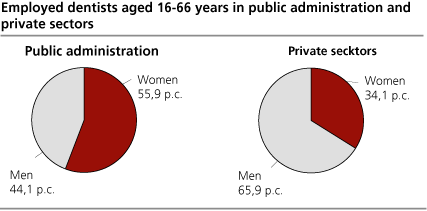Content
Published:
This is an archived release.
Increased employment for health care educated
The number of employees aged 16-66 with health care education increased by 4.4 per cent from the fourth quarter in 2004 to the same quarter in 2005.
The increase in the employment rate was a result of both more persons with health care education in the population, and an increased employment rate. The rate increased from 86.9 per cent in the fourth quarter 2004 to 87.2 per cent in the same quarter 2005. The unemployment rate for people with health care education was low, at 0.8 per cent.
The majority of employed persons with health care education, 77.3 per cent, worked in health care services.
High female rates
84.5 per cent of those employed with health care education were women. In some of the educational groups the female rate was over 99 per cent, like medical secretaries, dental secretaries, midwives and public health nurses.
Men were the majority in a few educational groups. These were physicians, dentists, dental technicians, optometrists, chiropractors and paramedics. But in all these groups the share of women increased.
Less in general government in Oslo
In total, general government employed 84.6 per cent of those with health care education. This was a decrease by 0.2 percentage points from 2004 and 0.6 percentage points from 2003. Sogn and Fjordane, Troms, Nordland, Aust-Agder, Møre and Romsdal and Nord-Trøndelag all had more than 90 per cent employed in general government. Oslo had the lowest portion with 71.3 per cent..
Lower portion without health care education
Employed persons without a health care education in the health care services, decreased from 37.8 per cent in the fourth quarter of 2004 to 36.1 per cent in 2005.
A large portion of the employees without a health care education had administrative jobs, or tasks as cleaning, preparing meals and maintenance.
Tables:
- Table 1 Number of persons with health care education by category of personnel and employmentstatus. 4. q. 2005
- Table 2 Number of persons aged 16-66 with health care education by category of personnel and employment. Absolute figures and as per cent of employed. 4. q. 2004 og 2005
- Table 3 Employed persons aged 16-66 with health care education by category of personnel and settled man-years. Per cent of employed and per cent of settled man-years. 4. q. 2005
- Table 4 Employed persons aged 16-66 with health care education, total and by category of personnel and industry Total and per cent change. 4. q. 2004 og 2005
- Table 5 Employed persons aged 16-66 with health care education by category of personnel and settled working hours. 4. q. 2005
- Table 6 Employed persons aged 16-66 with health care education who are working in the health care industry by category if personnel and sector. 2005
- Table 7 Employed persons aged 16-66 with health care education who are working in the health care industry by category if personnel and function. 2005
- Table 8 Employed persons, aged 16-66 and settled man-years, with health care education, by category of personnel. 4. q. 2004 and 2005. Change in per cent
- Table 9 Employed persons aged 16-66 with foreign citizenship with health care education in the health care industry that have been working in Norway less than 5 years. 1 October 2005
- Table 10 Employed persons aged 16-66 with foreign citizenship with health care education in the health care industry 1 October 2005
Contact
-
Arbeidsmarked og lønn
E-mail: arbeidsmarked@ssb.no
-
Fredrik Steinrem Edelmann
E-mail: fredrik.edelmann@ssb.no
tel.: (+47) 40 90 24 60
-
Sophie Sæternes
E-mail: sophie.saeternes@ssb.no
tel.: (+47) 98 67 14 26
-
Stine Bakke
E-mail: stine.bakke@ssb.no
tel.: (+47) 91 52 62 51

